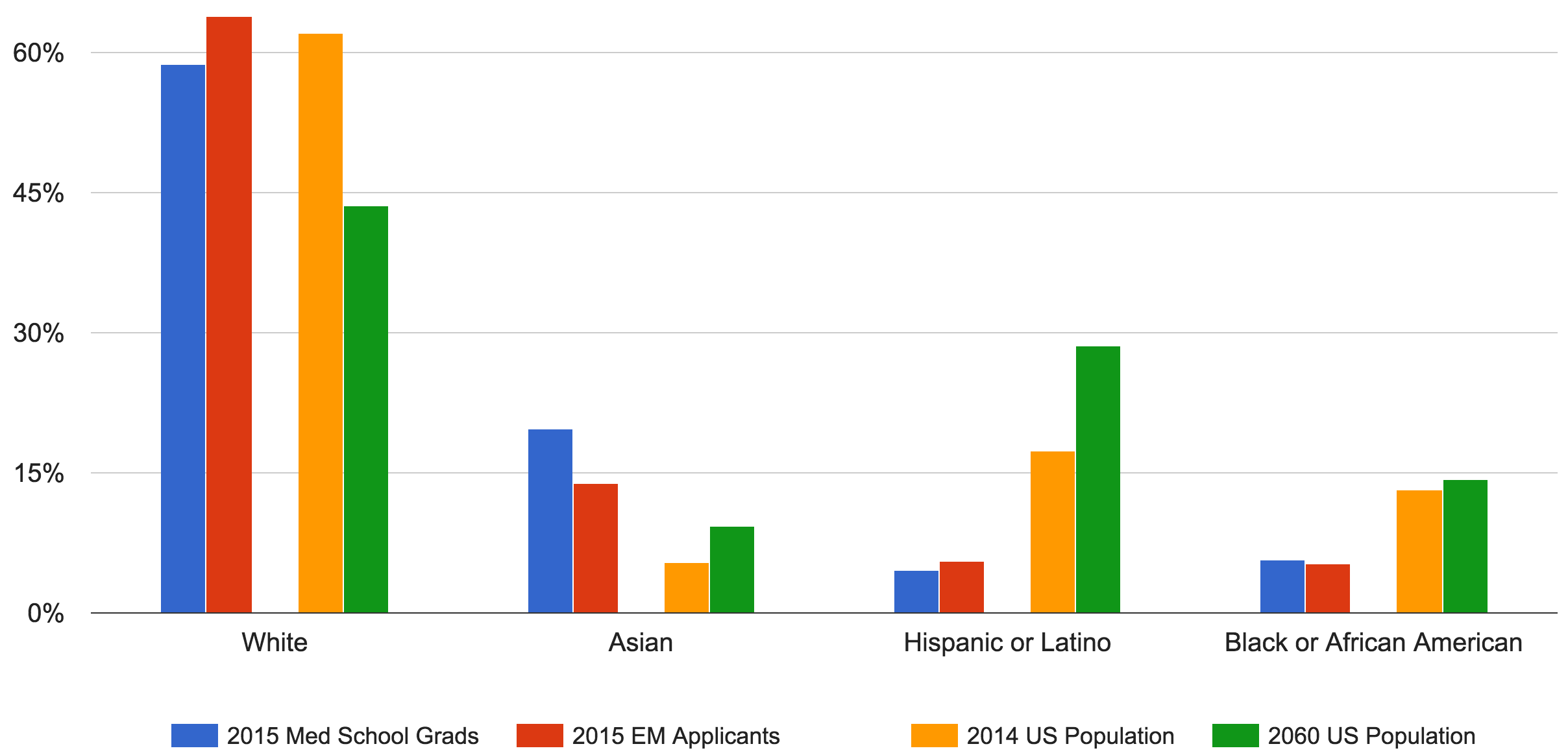The Importance of a Diverse Physician Workforce
In 2015, the Association of American Medical Colleges (AAMC) released a report highlighting that the number of black males applying for and matriculating into medical school hasn't budged in nearly 40 years. News of this ongoing imbalance in the makeup of the physician workforce came as no surprise to those who have dedicated themselves to reducing health care disparities.
Aside from the intrinsic value of learning and working in a diverse environment, diversifying the physician workforce has specifically been shown to increase access to care for racial and ethnic minorities, the un- and underinsured, and non-English speaking patients. Building a strong pipeline of high school, college, and medical school graduates from all backgrounds could help produce a physician workforce as diverse as the patient population we serve – not just in the emergency department, but in medicine as a whole. Tackling this challenge now is especially important as our national demographics continue to shift in a way that will create an even greater need for culturally competent providers in the future.
Figure 1. Comparison of racial and ethnic proportions of medical school graduates, emergency medicine residency applicants, and the current/projected population of the United States.*

*Medical school graduate and emergency medicine residency application data obtained from AAMC FACTS (aamc.org/data/facts). Population projections obtained from U.S. Census Bureau (census.gov/population/projections/data/national/2014.html). Data for “American Indian or Alaskan Native” and “Native Hawaiian or Other Pacific Islander” not included because they would not be interpretable at this scale, accounting for 1.2% and 0.2% of the current population, respectively, and 0.1% and 0.0% of medical school graduates/EM applicants, respectively.
Mentorship
The majority of underrepresented minority physician leaders credit at least part of their success to a mentor who helped make connections and unlock opportunities to advance their careers. For underrepresented students without a mentor or support community, here are a few organizations to explore:
ACEP: When you join EMRA, you automatically join ACEP as well – and the College is pursuing a strategy to increase diversity in leadership positions. “We're going to hold a diversity summit this spring to begin the conversation about diversity and how to enhance it more than ever,” said ACEP President-Elect Rebecca Parker, MD, FACEP. “We are going to be looking at diversity not only from the attending level but all the way to our students, because we want to capture the best and the brightest for our future, and we know diversity is an important part of that.”
SNMA: Formed in 1964, the Student National Medical Association is “committed to supporting current and future underrepresented minority medical students, addressing the needs of underserved communities, and increasing the number of clinically excellent, culturally competent and socially conscious physicians.” snma.org
EMRA is proud to co-sponsor an annual reception for students interested in pursuing emergency medicine at SNMA's Annual Medical Education Conference (AMEC), which this year will be held in Austin, Texas from March 23-27, 2016. We hope to see you there!
AMSA-REACH: The American Medical Student Association's Race, Ethnicity, and Culture in Health Action Committee has a tremendous list of resources available for students looking to get more involved. amsa.org/advocacy/action-committees/reach
AMA-MAS: The American Medical Association-Minority Affairs Section is free for all students, regardless of AMA membership. Notably, its scholarship programs have awarded more than $1 million during the past 20 years. ama-assn.org/ama/pub/about-ama/our-people/member-groups-sections/minority-affairs-section.page
SAEM-ADIEM: The Society for Academic Emergency Medicine's Academy for Diversity and Inclusion in Emergency Medicine is an excellent place to find an EM mentor. saem.org/saem-community/academies
Visiting Elective Scholarship Programs
As the health care system and residency training programs in particular continue to see the value of increasing the diversity of their organizations, minority applicants are being actively sought. Third-year medical students planning their away EM rotations should consider the list of programs that offer travel stipends/scholarships to visiting underrepresented minority students (see Figure 2).
Figure 2. Visiting Elective Scholarship Programs
* Updated list of URM opportunities and resources: Diversity Oriented Away Scholarship Programs
The Benefits of EMRA Membership
Finally, URM or not, no list of resources would be complete without highlighting all of the benefits students receiving by joining EMRA. From clinical and advising resources, to awards and scholarships, leadership opportunities, resident mentorship, EMIG resources, and complimentary attendance to EMRA's regional and national medical student symposia, EMRA has the tools to help you succeed.
Join today at emra.org/students!



